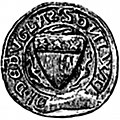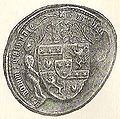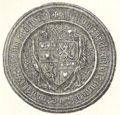Earl of Douglas

This page is concerned with the holders of the forfeit title Earl of Douglas and the preceding
Origins
Mythic beginnings
The Earls of Douglas, chiefs of
Historicity


The first Douglas on record in Scotland is William I, Lord of Douglas (c. 1174-1214), where he was witness to a charter of bishop Jocelin of Glasgow in 1198, where he signed "Will. de Dufglas" in what can only be a territorial designation.[4] It can be deduced however, that there was a connection to the House of Moray and its progenitor, Freskin, Lord of Duffus, insofar as the later blazon of both Houses both contained three stars argent on a field azure; further in a document pertaining to Bricius de Douglas, William of Douglas's son and Bishop of Moray, he refers to his avunculus Freskin of Kerdal, an unusual name for the time in Scotland.[5] This connection with the Morays can be later attested in a rhyme penned by Andrew of Wyntoun around the time of the marriage of Archibald the Grim to Johanna de Moravia the Moray heiress, of which further below:
Of Murrawe and the Douglas,
How that thare begynnyng was,
Syn syndry spekis syndryly
I can put that in na story.
But in thare armeyis bath thai bere
The sternys[stars] set in lyke manere;
Til mony men it is yhit sene
Apperand lyk that had bene
Of kyn be descens lyneale
Or be branchys collaterele[6]
It is also attested to by the fact that Archibald the Grim and Johanna de Moravia had to receive permission from the pope to marry because of consanguinity.
Famous art works
In the early 16th century Charles II D'Amboise commissioned Bernardino de' Conti to do a portrait painting for him in 1505 AD.[7] Although a friend and patron of Leonardo Da Vinci, D'Amboise picked de' Conti for his traditional style of oil painting.
Prominently inscribed on the top left the painting reads, "The Earl of Douglas surnamed Black Dudley" (referring to James, Lord of Douglas).
It is unknown how many renditions de' Conti created, but there is one that resides in the Seattle Art Museum, another once owned by Henry VIII belongs to the Royal Family,[8] and at least one belongs in a private collection.
Rise to power
Sir William the Hardy is the first of the Douglas Lords on record to take a major part in domestic and international affairs. He partook in Wallace's uprising against English rule in Scotland and died captive in the Tower of London.[9] His son Sir James Douglas, his estates forfeit to the English crown, swore allegiance to Robert the Bruce in 1306 prior to the latter's coronation, and was to share the deprivations and small victories of Bruce during the years leading up to Bannockburn. Afterwards he was appointed Warden of the Western March on the Scottish Border. Following Bruce's death, Sir James Douglas, now known as either "the Black Douglas" to the English, or the "Good Sir James" to the Scots, took the King's heart on crusade, and died fighting the Moors in Spain.[10]
Earldom of Douglas
The Good Sir James's nephew
William, the 1st Earl, Archibald the Grim and both his son the 4th Earl and grandson, the 5th Earl fought in France as well as the along the Anglo-Scottish Border, during what would become known as the
The 5th Earl's sons, the sixteen-year-old William Douglas, 6th Earl of Douglas and his brother David Douglas, were to be victim to the cabal of Sir William Crichton, Sir Alexander Livingston of Callendar, and their great uncle James Douglas, Earl of Avondale who wished to break the power of the Black Douglases. The boys were summoned to Edinburgh Castle, and where at what is known as the "Black Dinner" the Earl and his brother were taken into the Castleyard and executed before the young king.[13]
Downfall of the Black Douglases
The Earl of Avondale, the boys' great uncle and supposed conspirator into their deaths, became the 7th Earl of Douglas; known as "James the Gross" he inherited all the Douglas patrimony and died in 1443. Far from breaking Douglas power, the death of the 6th Earl consolidated it into the hands of the five formidable sons of James the Gross. James II of Scotland, exasperated at his overmighty vassal,
Black and Red Douglases
Following the death of the 2nd Earl at the
The Black Douglases fell from power and were attainted by King James II in 1455. The seventh Earl was created Earl of Avondale and Lord Balveny in 1437, also in the Peerage of Scotland. These titles also became forfeit in 1455.
The title of Douglas was restored in 1633 for the "Red" Douglas line, when
Lords of Douglas
- William I, Lord of Douglas (died c. 1214)
- Archibald I, Lord of Douglas (died c. 1240)
- William Longleg, Lord of Douglas (c. 1220–c. 1274)
- William 'The Hardy', Lord of Douglas (c. 1240–1298) Died captive in the Tower of London
- James 'The Good', Lord of Douglas (c. 1290–1330) Killed at the Battle of Teba
- William IV, Lord of Douglas (died 1333) Killed at the Battle of Halidon Hill
- Hugh the Dull, Lord of Douglas (1294–c. 1345) resigned Lordship 1342
- William, Lord of Douglas (1327–1384) Created first Earl 1358.
Earls of Douglas (1358)
- William Douglas, 1st Earl of Douglas (1327–1384)
- James Douglas, 2nd Earl of Douglas (1358–1388), killed at the Battle of Otterburn
- Archibald Douglas, Lord of Galloway, 3rd Earl of Douglas (1325–1400) "the Grim", Bastard cousin of the 1st Earl, created Earl of Wigtown[14] 1372
- Archibald Douglas, 4th Earl of Douglas (1370–1424) Duke of Touraine, killed at the Battle of Verneuil
- Archibald Douglas, 5th Earl of Douglas (1390–1439), son of the above
- Black Dinner at Edinburgh Castle
- James Douglas, 7th Earl of Douglas (died 1443) "the Gross" created Earl of Avondale in 1437, murderer and great-uncle of above.
- William Douglas, 8th Earl of Douglas and 2nd Earl of Avondale (1425–1452), Murdered by James II of Scotland at Stirling Castle.
- James Douglas, 9th Earl of Douglas and 3rd Earl of Avondale (died 1488), the last "Black Douglas", brother of the previous, attainted 1455 and all his titles forfeit.
Lordship of Douglas, and other estates and title devolved upon: George Douglas, 4th Earl of Angus
Other titles held
The following titles were held by the Earl of Douglas, at various times.
- Dukedom of Touraine
- Earldom of Mar
- Earldom of Wigtown
- Earldom of Avondale
- Lordship of Balvenie- subsidiary title of Lord Avondale
- Earldom of Moray
- Earl of Ormonde
- Lordship of Annandale
- Lordship of Galloway
- County of Longueville
- Seigneurie of Dun-le-Roi
Family tree
| |||||||||||||||||||||||||||||||||||||||||||||||||||||||||||||||||||||||||||||||||||||||||||||||||||||||||||||||||||||||||||||||||||||||||||||||||||||||||||||||||||||||||||||||||||||||||||||||||||||||||||||||||||||||||||||||||||||||||||||||||||||||||||||||||||||||||||||||||||||||||||||||||||||||||||||||||||||||||||||||||||||||||||||||||||||||||||||||||||||||||||||||||||||||||||||||||||||||||||||||||||||||||||||||||||||||||||||||||||||||||||||||||||||||||||||||||||||||||||||||||||||||||||||||||||||||||||||||||||||||||||||||||||||||||||||||||||||||||||||||||||||||||||||||||||||||||||||||||||||||||||||||||||||||||||||||||||||||||||||||||||||||||||||||||||||||||||||||||||||||||||||||||||||||||||||||||||||||||||||||||||||||||||||||||||||||||||||||||||||||||||||||||||||||||||||||||||||||||||||||||||||||||||||||||||||||||||||||||||||||||||||||||||||||||||||||||||||||||||||||||||||||||||||||||||||||||||||||||||||||||||||||||||||||||||||||||||||||||||||||||||||||||||||||||||||||||||||||||||||||
Seals of the Douglas Lords
-
Seal of William le Hardi, Lord of Douglas
-
Seal attributed to William, 1st Earl of Douglas,
-
Seal of Archibald the Grim, 3rd Earl of Douglas
-
Seal of the 4th Earl of Douglas, Duke of Touraine
See also
Red Douglas
- Duke of Douglas.
- This line is represented now by the Dukes of Hamilton, the heirs male of the House of Douglas.
Other lines
- Earl of Home (in the female line), in the capacity of Lord Douglas of that Ilk
- Earl of Queensberry (since 1633), later Marquess of Queensberry (since 1682) and Duke of Queensberry(1684—1810).
- Earl of Morton (since 1458)
- Baron Penrhyn (since 1866)
- Swedish-German Line: Descendants of Robert Douglas, Count of Skenninge (1611-1662)
Notes
This article needs additional citations for verification. (July 2013) |
- ^ Godscroft, pp 1-6
- ^ Maxwell, Vol I, chap I, pp.1-12
- ^ Godscroft, pp. 7-14
- ^ Liber de Calchou, p346
- ^ Fraser, vol I, p.37
- ^ Wyntoun, Andrew of, Book VIII, Chap. VII,p. 320-321
- ^ Seattle Art Museum. "Charles d'Amboise Portrait by Bernardino de' Conti". localhost. Retrieved 5 September 2021.
{{cite web}}: Check|url=value (help) - ^ Royal Collection Trust. "The Earl of Douglas Surnamed Black". Archived from the original on 5 September 2021.
- ^ Dictionary of National Biography (1885-1900 ed.). p. 15:354–55.
- ^ Dictionary of National Biography (1885-1900 ed.). p. 15:301–304. Retrieved 29 August 2016.
- ^ Maxwell, Vol.I, p.81
- ^ Fraser Vol.I, p.234
- ^ Dictionary of National Biography (1885-1900 ed.). p. 16:361. Retrieved 29 August 2016.
- ^ Maxwell, VolI, p118
References
- Brown Michael. The Black Douglases-War and Lordship in late Medieval Scotland. East Linton 1998
- Fraser, Sir William, The Douglas Book IV vols. Edinburgh 1885.[1]
- Godscroft, David Hume of. The History of the House and Race of Douglas and Angus. London 1820
- Maxwell, Sir Herbert. A History of the House of Douglas II Vols. London 1902
- Laing. Edinburgh 1872. [2]




